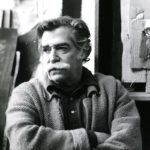Clavé, Antoni

Clavé was a painter, draftsman, engraver, stage designer and sculptor born in Barcelona in 1913.
He estudied at the School of Fine Arts of Barcelona with Fèlix Mestres and he was a disciple of Angel Ferrant and Josep Mongrell. His first professional works were related to illustration and advertising posters.
Around 1934 he started to experiment with new materials and collage, which he picked up again when the Civil War ended and when he was released from a concentration camp in the south of France.
Thanks to the help of the painter Rousillon Martin Vivès, he took refuge in Perpignan, where he exhibited some of his drawings and gouaches before he left for Paris. Once established in the city of the Seine, he began to present his artworks in all the Autumn Salons between 1940 and 1948, and to publish illustrations and lithographs.
In 1946 he was debuted as a stage designer in the ballet Los Caprichos, which caused him to develop an interest in producing costumes and decorations for plays, operas and ballets (Carmen, La Casa de Bernarda Alba..). At the same time his artistic production started to trascend the limits of parisian culture.
In 1948 he was awarded with the Hallmark prize in New York and since then he started to have various exhibitions all over the world: Oran, New York, Sweden, London, Rome, Chicago, Venice, Sao Paulo, Milano, Zurich, Tokyo, Madrid, etc; In Barcelona it was Sala Gaspar that organized in 1956 his first solo exhibition. While a year earlier Clavé staged his last ballet, titled Roland Petit in Les Peux.
In 1960 he introduced new techniques to his art, such as paint on tapestry, lead sculptures, reliefs and assemblages (compositions with fragments of cloth or tapestry). His works and bas-reliefs in lead, such as the mysterious and quadrangular warriors and kings, started to appear in his paintings from the illustrations for Gargantua by Rabelais, that he made in 1950, which demonstrate the usefulness of the soft and malleable metal to obtain textures and qualities of extraordinary expressive force.
During the 70s Clavé\'s desire to renew his technique persisted and he inaugurated his series of assemblies with strings and woods (Instruments) and his series of crumpled packaging papers.
Throughout the 80s Clavé\'s work was exhbitited in Barcelona, Madrid, Valencia, Zaragoza and Alicante, boosting his recognition in Spain. In addition he participated in the Venice Biennal pavilion, showcasing 125 artworks. At the same time, he created a mural at the Barajas airport, as well as a series of artworks tribute to Pablo Picasso (A Don Pablo).
Clavé’s international exhibitions continued for the rest of his life in New York, Habana, Tokyo, Osaka, Paris, Arles, Nice and more, having significant retrospectives.